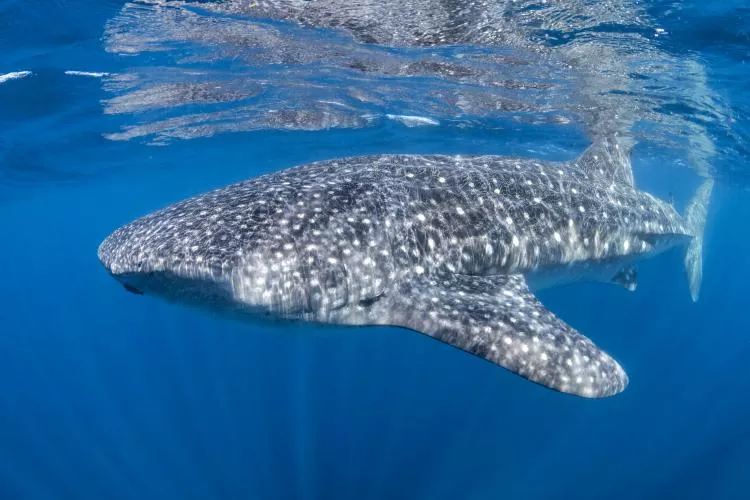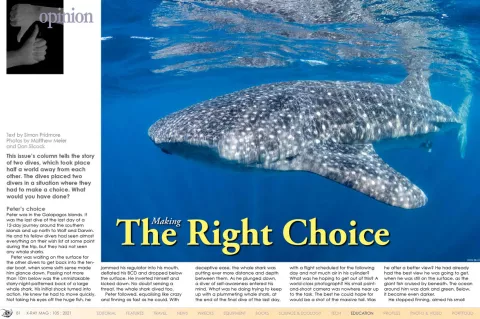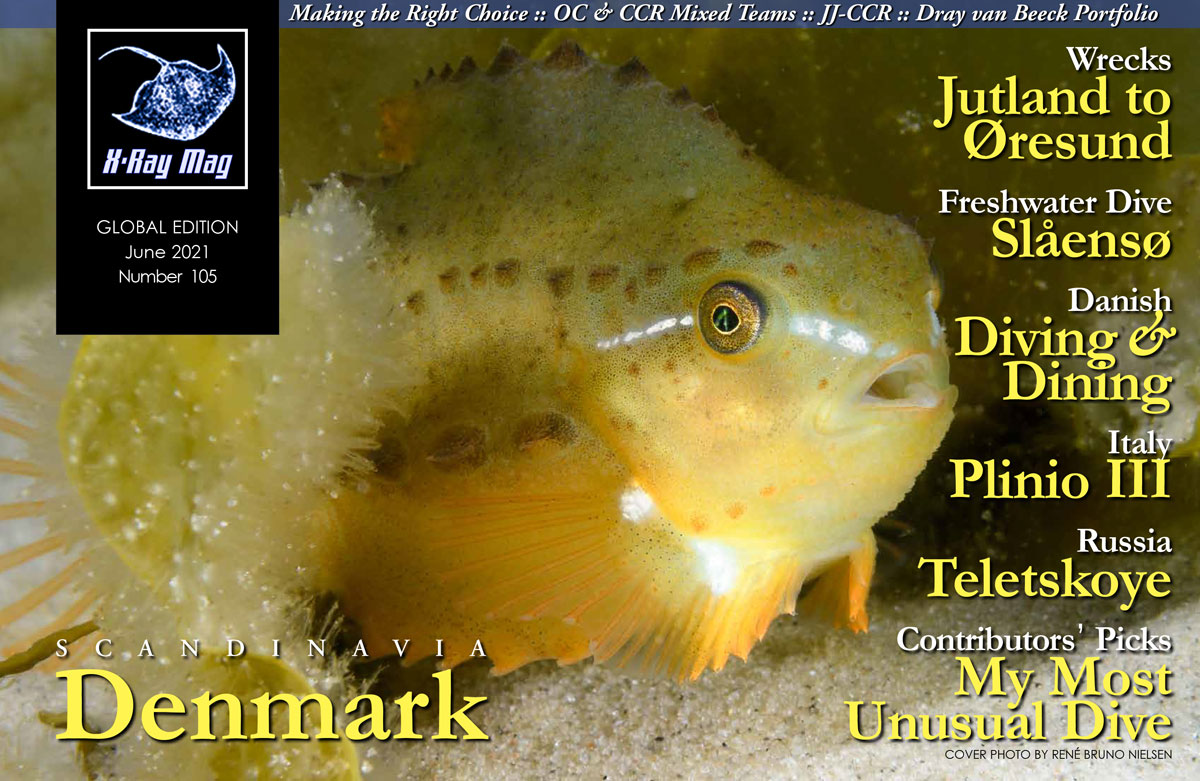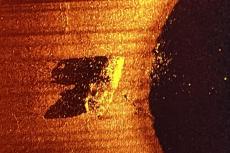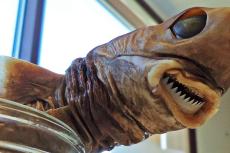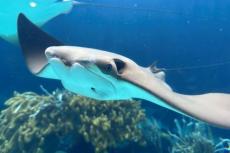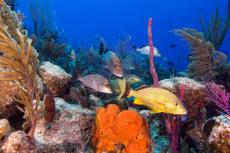This issue’s column tells the story of two dives, which took place half a world away from each other. The dives placed two divers in a situation where they had to make a choice.
Contributed by
What would you have done?
Peter’s choice
Peter was in the Galapagos Islands. It was the last dive of the last day of a 12-day journey around the southern islands and up north to Wolf and Darwin. He and his fellow divers had seen almost everything on their wish list at some point during the trip, but they had not seen any whale sharks.
Peter was waiting on the surface for the other divers to get back into the tender boat, when some sixth sense made him glance down. Passing not more than 10m below was the unmistakable starry-night-patterned back of a large whale shark. His initial shock turned into action. He knew he had to move quickly. Not taking his eyes off the huge fish, he jammed his regulator into his mouth, deflated his BCD and dropped below the surface. He inverted himself and kicked down. No doubt sensing a threat, the whale shark dived too.
Peter followed, equalising like crazy and finning as fast as he could. With deceptive ease, the whale shark was putting ever more distance and depth between them. As he plunged down, a sliver of self-awareness entered his mind. What was he doing trying to keep up with a plummeting whale shark, at the end of the final dive of the last day, with a flight scheduled for the following day and not much air in his cylinder? What was he hoping to get out of this? A world-class photograph? His small point-and-shoot camera was nowhere near up to the task. The best he could hope for would be a shot of the massive tail. Was he after a better view? He had already had the best view he was going to get, when he was still on the surface, as the giant fish cruised by beneath. The ocean around him was dark and green. Below, it became even darker.
He stopped finning, aimed his small camera at the whale shark’s large back and tail receding into the gloom and clicked. He checked his contents gauge, blinked in surprise at how little air he had left, and made a slow ascent back to the surface. He popped up a short distance away from the tender boat and was swiftly spotted.
The rest of his team were very pleased to see him. They had feared the worst after they lost sight of him. When Peter got back on the liveaboard, he downloaded his photos from the dive and then lightened and increased the contrast on the last hastily snapped shot. The whale shark was almost invisible in the murk. All you could see were the distinctive white flashes on a light grey, vaguely shark-shaped background.
Peter looked at the picture and reflected on the fact that this was a small reward for risking his neck. He wondered again at what had possessed him to embark on his wild ride and was relieved that he had come to his senses in time to put the brakes on and get back to the surface before he ran out of air completely.
Andrew’s choice
Andrew was on his third dive of the day in Indonesia’s Banda Sea. Over the previous couple of days, he and his group of divers had seen large schools of hammerhead sharks out in the blue as well as a few individuals that had come close to check out the divers, before veering away.
This dive, however, was very different. The divers had already been in the water for some time when their guide spotted a huge group of hammerheads swimming towards them. The divers were at a depth of around 27m and the sharks seemed to be about 15m below them. Andrew knew that if he stayed where he was, he would only get to see the school passing by in the distance, as on their previous dives. This time, he wanted to get closer.
There was a strong current running, but he began to crawl down the slope, using his pointer with one hand like a grappling hook, jamming it behind rocks and into crevices. The other hand was occupied with his video camera, which he directed at the approaching hammerheads. He arrived at a depth of 38m and wedged himself into the slope to get a stable base to film from.
The view was incredible. The school of hammerheads flowed past him, some almost within touching distance. They were in a long line, their bodies undulating effortlessly as they cruised by. Still, they kept coming. He heard someone tapping insistently and glanced up. It was the dive guide, motioning him to ascend to a shallower depth.
Andrew knew that he must be low on air and was probably in deco, but he did not dare take his eye off his viewfinder. He was getting the best footage he had ever shot. He ignored the guide and kept filming the school as it patrolled past him. Soon, they were gone.
Just as he was about to ascend, he turned and saw, in the distance, another big school of hammerheads approaching. Without thinking, he swam towards it, the adrenaline pumping through his veins. This was truly the dive of his life. The hammerheads almost filled his screen, and they were coming ever closer.
Then, he ran out of air.
He tried to take a breath, but there was nothing there. He looked around. The guide and the other divers had left. All he could do was try to get to the surface before he drowned. He swam up, with no other thought in his mind but that he had to get air. His regulator was still in his mouth. He was not going to make it. He had to take a breath. He inhaled cautiously and got a mouth full of sea instead of air. The water touched his throat and he choked, spitting the water out.
He was still finning as hard as he could, up towards the light, the regulator mouthpiece gripped between his teeth. Almost immediately, the urge to breathe returned, an urge he could not resist. He inhaled again, expecting nothing, but miraculously there was air. It was not much, but it was enough to get him through the final few metres. He broke the surface, removed his regulator and took several lungfuls of air, gasping. He inflated his BCD orally and waited for the boat to pick him up.
The guide had witnessed the whole thing and was as relieved as Andrew was that he was still alive. He made him breathe pure oxygen for a while and told him that he would have to skip the next day’s diving, the final day of their trip, so that he would have a good 48 hours between diving and flying.
Fortunately, Andrew suffered no symptoms of decompression sickness following his rapid emergency ascent.
Every time he subsequently showed the video from the dive and told this story (which was often), he would always say he had no regrets about doing the dive the way he did.
Would he do it again? “No way,” he shakes his head. “But that is because I have already done it!” You would notice, however, that when he says this, his wife, the mother of their two children, does not join in with the nervous laughter that always follows.
Dealing with dilemmas
Both these guys lived to dive another day, which is just as well; otherwise, we wouldn’t know their stories. A diver who finds that they are in a position of having to make a crucial choice on the spur of the moment, when the adrenaline is running and narcosis is dulling the brain, is always at risk of making a flawed decision and taking the wrong course of action.
At some point, any of us may find ourselves confronted with a dilemma similar to the one these two guys had to deal with. Self-discipline is the key, of course, but you don’t know if you have got enough of it—if you are a Peter or an Andrew—until the moment arrives and you are put to the test.
A good strategy is to establish some personal rules to dive by. Work these out in the cold light of day, rationally and with plenty of sober reflection. Your list may include things like: “Once I am on the surface, the dive is always over,” “Never go into deco on a single tank,” “Always surface with at least 30 bar,” or “Always carry a pony bottle below 30m.” You get the idea.
You choose your own rules; then make a promise to yourself to stick to them, no matter what. Then, there is a better chance that you will make the right choice when your turn comes. ■
Simon Pridmore is the author of the international bestsellers Scuba Confidential: An Insider’s Guide to Becoming a Better Diver, Scuba Professional: Insights into Sport Diver Training & Operations and Scuba Fundamental: Start Diving the Right Way. He is also the co-author of the Diving & Snorkeling Guide to Bali and the Diving & Snorkeling Guide to Raja Ampat & Northeast Indonesia. His recently published books include The Diver Who Fell From The Sky, Dive into Taiwan, Scuba Exceptional: Become the Best Diver You Can Be, Scuba Physiological: Think You Know All About Scuba Medicine? Think Again! and the Dining with Divers series of cookbooks. For more information, see his website at: SimonPridmore.com.

